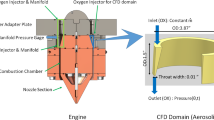Abstract
The effect of the simulated ice accretion on the dynamic distortion of a diffusing S-duct inlet is numerically investigated. The LES turbulence model is used to simulate the unsteady flow separation and vortex shedding from the duct curvatures and ice accretion. The numerical methods for unsteady-flow solutions are validated with the wind-tunnel test data for dynamic inlet distortion. The results show that the protruding glaze ice horns create the strong vortex shedding structures that produce additional flow unsteadiness at the inlet engine face. In particular, the symmetrical glaze ice that uniformly covers the entire inlet lip increases the total pressure loss and fluctuation level more than the asymmetrical glaze ice with a less blockage to inlet flow. Furthermore, the symmetrical glaze iced inlet induces 17 times more severe instantaneous peak distortion than clean inlet at the free stream Mach number of 0.34.










Similar content being viewed by others
Abbreviations
- \(D_{\mathrm{th}}\) :
-
Throat diameter (m)
- LES:
-
Large eddy simulation
- LWC:
-
Liquid water contents \((g/m^{3})\)
- \(M_{\mathrm{th}}\) :
-
Throat Mach number of baseline inlet \((\sim )\)
- MVD:
-
Mean volume diameter (\(\mu \)m)
- \(M_{\infty }\) :
-
Free-stream Mach number (\(\sim )\)
- PD:
-
Peak distortion parameter (\(\sim )\)
- Ps:
-
Static pressure (kPa)
- \(Pt_{\mathrm{{PD}}}\) :
-
Total pressure at peak distortion (kPa)
- \(Pt_{\infty }\) :
-
Free-stream total pressure (kPa)
- \(\overline{\mathrm{Pt}} _{\mathrm{ef}} \) :
-
Area- and time-averaged total pressure at engine face (kPa)
- \(\overline{\mathrm{Pt}} _{\mathrm{ef-clean}}\) :
-
Area- and time-averaged total pressure at engine face of clean inlet (kPa)
- \(\overline{\mathrm{Pt}} _{\mathrm{ef-INS}}\) :
-
Instantaneous area-averaged total pressure at engine face (kPa)
- \(\overline{\mathrm{Pt}} ^{{\prime }}\) :
-
Area-averaged total pressure fluctuation at the engine face (kPa)
- \(\overline{\mathrm{Pt}} _{\mathrm{RMS}}^{\mathrm{\prime }} \) :
-
Root mean square of total pressure fluctuation at engine face (kPa)
- \({\overline{\mathrm{Q}}}_{\mathrm{ef}}\) :
-
Area-averaged dynamic pressure at engine face (kPa)
- RMS:
-
Root mean square
- \(T_{\infty }\) :
-
Free-stream static temperature (\(^\circ \)C)
- \(\Delta \)t:
-
Time step size (s)
- \(V_{\infty }\) :
-
Free-stream velocity
- \(y^{+}\) :
-
Non-dimensional wall distance \((\sim )\)
- \(\theta \) :
-
Circumferential angle (deg.)
References
Macmiller C, Haagenson W (1986) Unsteady inlet distortion characteristics with the B-1B. The propulsion and energetic 68th (A) specialists meeting, Munich, Germany
Jin W, Taghavi R, Farokhi S (2011) A computational investigation of icing effects on an S-Duct. Int. J. Turbo Jet Eng. 27(3):277–294
Zaman K, Potapczuk M (1989) The low frequency oscillation in the flow over a NACA 0012 airfoil with an ‘Iced’ leading edge. NASA TM-102018
Bragg M, Khodadoust A, Spring S (1992) Measurement in a leading-edge separation bubble due to a simulated airfoil ice accretion. AIAA J. 30(6):1462–1467
Gurbacki H, Bragg M (2002) Unsteady aerodynamic measurements on an iced airfoil. AIAA Paper 02-13576
Potapczuk M (1988) Numerical analysis of an NACA 0012 airfoil with leading-edge ice accretion. J. Aircr. 25(3):193–194
Bragg M, Khodadoust A, Spring S (1992) Measurement in a leading-edge separation bubble due to a simulated airfoil ice accretion. AIAA J. 30(6):1462–1467
Kim H, Bragg M (1999) Effects of leading–edge ice accretion geometry on airfoil performance. AIAA Paper 99-3150
Chung J, Choo Y, Reehorst A, Potapczuk M, Slater J (1999) Navier-stokes analysis of the flowfield characteristics of and ice contaminated aircraft wing. AIAA Paper 99-0375
Willmer A, Brown T, Goldsmith E (1981) Effects of intake geometry on circular pitot intake performance at zero and low forward speeds. In: aerodynamics of power plant installation, Toulouse, France p 5.1–5.16 (AGARD CP301, Paper 5)
Gibb J, Jackson M (1992) Some preliminary results from tests using vortex generators in the circular/circular diffusing S-Duct model M2129 test phase 3. Defense research agency Rept. AP4(92)WP15
Papadakis M, Zumwalt G, Elangonan R, Freund G, Breer M, Whitmer L (1989) An Experimental Method for Measuring Water Droplet Impingement Efficiency on Two- and Three-Dimensional bodies. NASA-CR-4257
Farokhi S (2008) Aircraft Propulsion. Wiley, New York
Bidwell C, Mohler S (1995) Collection Efficiency and Ice accretion Calculations for a Sphere, a Swept MS(1)-317 wing, a Swept NACA-0012 Wing Tip, an Axisymmetric Inlet, and a Boeing 737-300. AIAA Paper 95-0755
Bidwell C, Potapczuk M (1993) User’s Manual for the NASA Lewis Three-Dimensional Ice Accretion Code (LEWICE3D). NASA TM-105974
GAMBIT Software Package, Ver. 2.2.30 (2004) Fluent Inc.
Anderson B, Farokhi S (1991) A study of three-dimensional turbulent boundary layer separation and vortex flow control using the reduced navier stokes equations. Turbulent Shear Flow Symposium, Munich
STAR-CCM+ Software Package, Ver. 2.10.013 (2007). CD-adapco Inc., Melville, New York
STAR-CCM+ 2.10.013 User’s guide (2007). CD-adapco Inc., Melville, New York
Pope S (2000) Turbulent Flow. Cambridge University Press, New York
Anderson B, Gibb J (1996) Vortex generator installation studies on steady state and dynamic inlet distortion. NASA TM-107220
Chen Y (1983) Statistical prediction of dynamic distortion of inlet flow using minimum dynamic measurement-an application to the Melick Statistical Method. Thesis, the University of Kansas, M. S
Hercock R, Williams D (1974) Distortion-induced engine instability and aerodynamic response. AGARD, LS72-Paper No. 3
Acknowledgements
This work was supported by INHA TECHNICAL COLLEGE Research Grant.
Author information
Authors and Affiliations
Corresponding author
Rights and permissions
About this article
Cite this article
Jin, W. Numerical Investigation of Icing Effects on Dynamic Inlet Distortion. Int. J. Aeronaut. Space Sci. 19, 354–362 (2018). https://doi.org/10.1007/s42405-018-0044-0
Received:
Revised:
Accepted:
Published:
Issue Date:
DOI: https://doi.org/10.1007/s42405-018-0044-0




